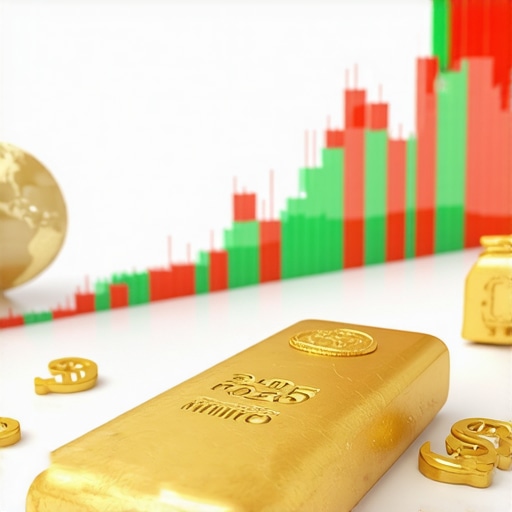Introduction to Gold Demand and Its Importance
Gold has long been regarded as a safe haven asset, holding intrinsic value through various economic climates. Understanding gold demand is crucial for anyone looking to invest in this precious metal, particularly beginners who may be unfamiliar with its market dynamics. In this guide, we will explore the factors influencing gold demand and how they can impact investment decisions.
Key Factors Influencing Gold Demand
Several factors contribute to the fluctuations in gold demand, making it essential for investors to stay informed. One primary factor is economic uncertainty. During times of financial instability, investors often flock to gold as a hedge against inflation and currency devaluation. This trend can be particularly observed during global crises, where gold prices tend to rise significantly.
Another crucial element is the jewelry sector. A significant portion of gold demand comes from countries like India and China, where gold jewelry holds cultural and economic significance. Understanding these regional demands can provide insights into global market trends.
Investment Demand
Gold also sees considerable demand from investors through various investment vehicles, including gold bullion, ETFs, and mutual funds. As more investors look to diversify their portfolios, the demand for gold-based investments continues to grow. For instance, the popularity of gold ETFs has surged, offering a way for investors to gain exposure to gold without needing to physically hold the metal.
Global Economic Indicators
Monitoring global economic indicators is essential for understanding gold demand. Factors such as interest rates, inflation rates, and geopolitical tensions can heavily influence the desire for gold. For example, when interest rates are low, gold becomes a more attractive investment compared to interest-bearing assets, leading to increased demand.
Conclusion
In conclusion, understanding gold demand is vital for beginners looking to navigate the complexities of gold investment. By considering factors such as economic uncertainty, cultural influences, and global economic indicators, investors can make informed decisions about their gold investments. For more insights on gold investment strategies, check out our post on top gold investment strategies to enhance your knowledge further.
Emerging Trends in Gold Demand
The landscape of gold demand is constantly evolving, influenced by a myriad of factors ranging from economic shifts to technological advancements. As an investor, it is crucial to stay abreast of these emerging trends to make informed decisions. One notable trend is the growing interest in gold-backed digital assets. With the rise of cryptocurrencies, many investors are exploring the potential of digital gold as a secure investment alternative.
Impact of Central Bank Policies
Central banks play a pivotal role in shaping gold demand. Their policies regarding gold reserves can significantly influence market dynamics. For example, when central banks increase their gold holdings, it often signals a lack of confidence in fiat currencies, driving up gold prices. Understanding how central bank purchases affect gold investment is essential for anticipating market movements.
Cultural Significance of Gold in Investment Decisions
Cultural factors also heavily influence gold demand, particularly in countries like India and China, where gold is not only an investment but a symbol of wealth and status. The jewelry market in these regions remains robust, with demand peaking during festivals and wedding seasons. Recognizing these cultural dynamics can provide investors with a competitive edge when considering gold investment opportunities.
Gold as a Hedge Against Inflation
In times of rising inflation, gold often emerges as a preferred investment choice. Many investors view it as a reliable hedge against currency devaluation. Historical data suggests that gold prices tend to increase when inflation rates rise, making it an attractive option for those looking to protect their purchasing power. For more insights on how gold functions as an inflation hedge, check out our article on key insights about gold and inflation.
Conclusion: Navigating the Future of Gold Demand
As we look ahead, understanding the intricacies of gold demand trends will be vital for investors. By considering factors such as emerging digital assets, central bank policies, and cultural influences, investors can better navigate the complexities of the gold market. Staying informed about these trends will not only enhance investment strategies but also improve decision-making processes. To delve deeper, explore our comprehensive guide on essential insights on gold investment techniques to refine your approach to gold investments.
Factors Influencing Gold Investment Decisions
The decision to invest in gold is influenced by various factors that extend beyond mere market trends. One of the most significant determinants is geopolitical stability. In times of uncertainty, such as political unrest or economic downturns, gold prices often surge as investors flock to safe-haven assets. Understanding how global supply and demand affects gold prices can provide valuable insights for strategic investments.
Technological Advancements in Gold Trading
Technological innovations are reshaping the gold trading landscape. The emergence of online trading platforms has made gold more accessible to a wider audience, enabling investors to buy and sell with ease. Furthermore, the rise of gold-backed cryptocurrencies exemplifies how technology is merging with traditional investments. Investors should consider gold ETFs as a modern approach to gold investment, offering liquidity and diversification.
Long-Term vs. Short-Term Gold Investment Strategies
Investors must decide whether to adopt a long-term or short-term strategy when investing in gold. Long-term investors typically view gold as a hedge against inflation and currency devaluation, allowing them to weather market fluctuations. In contrast, short-term traders may capitalize on price volatility, taking advantage of market dips and peaks. For those interested in short-term gains, exploring gold trading techniques can prove beneficial.
The Role of Economic Indicators
Economic indicators such as interest rates, unemployment rates, and GDP growth can significantly impact gold prices. For instance, lower interest rates often lead to higher gold prices as the opportunity cost of holding gold decreases. Additionally, monitoring inflation rates can provide clues about the future trajectory of gold investments. For investors looking to understand these dynamics more deeply, analyzing gold price trends can be invaluable.
Global Demand Trends in Gold Investment
The global demand for gold is also subject to shifts in consumer behavior, particularly in major markets like India and China. These countries have a rich cultural affinity for gold, driving demand for jewelry and investment purposes. By observing these cultural trends, investors can better anticipate market movements. To gain a comprehensive understanding of how gold demand trends affect prices, investors should stay informed about regional consumption patterns.
Environmental and Ethical Considerations
Modern investors are increasingly considering the environmental and ethical implications of their investments. Sustainable gold mining practices and ethical sourcing are becoming essential factors in the decision-making process. Investors who prioritize responsible investment strategies can find value in gold mining stocks that adhere to high environmental standards. This approach not only aligns with ethical values but also appeals to a growing demographic of socially conscious investors.
Market Trends and Their Influence on Gold Prices
The fluctuations in gold prices are closely tied to market trends. Investors need to stay informed about current events and economic shifts that can lead to substantial changes in gold valuations. For example, when stock markets experience volatility, gold often becomes a preferred investment, prompting a surge in demand. Understanding the drivers of gold price movements can help investors make well-timed decisions.
The Correlation Between Gold and Currency Strength
Gold prices typically have an inverse relationship with the strength of major currencies, particularly the US dollar. When the dollar weakens, gold becomes cheaper for foreign investors, often leading to increased demand. This dynamic is essential for investors to monitor, as shifts in currency values can significantly impact gold investment strategies. By keeping an eye on the forex market, investors can better predict potential price changes in gold.
Alternative Gold Investment Vehicles
While physical gold remains a popular choice, various alternative investment vehicles are gaining traction. Products like gold ETFs and gold mutual funds offer investors a way to gain exposure to gold without the complexities of storage and security associated with physical gold. These options provide liquidity and diversification, making them appealing for both novice and seasoned investors.
Understanding Gold Futures and Options
Investors interested in more sophisticated strategies may consider gold futures and options. These financial instruments enable investors to speculate on the future price of gold, allowing for potential profit from price fluctuations. However, they also come with higher risk. For those wanting to navigate this terrain, it is crucial to equip oneself with knowledge about gold futures trading and the associated market dynamics.
Assessing Gold’s Performance in a Portfolio
Integrating gold into an investment portfolio can provide a hedge against market volatility and inflation. The diversification benefits of including gold can enhance overall portfolio stability. Investors should regularly evaluate their gold holdings in conjunction with other assets to ensure optimal performance. For insights on how to effectively add gold to your investment strategy, staying updated on market trends and economic indicators is vital.
Conclusion: The Future of Gold Investment
As global circumstances evolve, so too will the landscape of gold investments. Understanding the interplay between market dynamics, geopolitical factors, and economic indicators is essential for any investor aiming to navigate the gold market successfully. By remaining informed and adopting a strategic approach, investors can capitalize on the opportunities that gold presents in today’s economic climate.
Frequently Asked Questions About Gold Investment
What factors influence gold prices?
Gold prices are influenced by various factors including market trends, currency strength, inflation rates, and global geopolitical events. Economic instability often leads to increased demand for gold as a safe-haven asset, driving prices higher.
Is investing in gold a good strategy for beginners?
Yes, investing in gold can be a good strategy for beginners as it provides a hedge against inflation and market volatility. However, it’s essential to understand the various forms of gold investment available, such as physical gold, ETFs, and mutual funds.
How can I invest in gold without buying physical gold?
Investors can invest in gold without purchasing physical gold through options like gold ETFs, mutual funds, and gold mining stocks. These alternatives provide exposure to gold’s price movements without the need for storage and security concerns.
Are gold futures a safe investment?
Gold futures can be risky and are generally suited for experienced investors. They allow for speculation on future gold prices, but they require a thorough understanding of market dynamics and risk management strategies.
How does gold perform during economic downturns?
Historically, gold has performed well during economic downturns. As a traditional safe-haven asset, it tends to attract investors during times of uncertainty, which can drive its price up.
What is the best way to add gold to my investment portfolio?
To effectively add gold to your investment portfolio, consider your overall investment goals, risk tolerance, and market conditions. A diversified approach that includes a mix of physical gold, ETFs, and other assets can enhance portfolio stability.
What are the tax implications of investing in gold?
Investing in gold can have tax implications based on the form of investment. For instance, selling physical gold may incur capital gains tax, while gold ETFs might be taxed differently. It is advisable to consult a tax professional for specific guidance.
Can I invest in gold through retirement accounts?
Yes, you can invest in gold through certain retirement accounts, such as a Self-Directed IRA, which allows for the inclusion of physical gold and other precious metals as part of your retirement portfolio.
What are the risks associated with gold investments?
Risks associated with gold investments include market volatility, changes in currency values, and geopolitical instability. Additionally, storage and security concerns for physical gold can also pose risks to investors.
Authority Resources for Gold Investment
For those looking to deepen their understanding of gold investment, consider referring to the following trusted resources:
- Investopedia – Gold Investment Basics
- Kitco – Precious Metals Market Information
- World Gold Council – Insights and Research on Gold
- BullionVault – Buy and Sell Gold and Silver
- CNBC – Financial News and Market Updates
Conclusion: Navigating the Gold Investment Landscape
In conclusion, understanding the nuances of gold investment—its market dynamics, trends, and available investment vehicles—is crucial for both novice and seasoned investors. By doing due diligence and leveraging authoritative resources, investors can make informed decisions that align with their financial goals. As the economic landscape continues to evolve, gold remains a valuable asset for those looking to diversify and safeguard their portfolios against uncertainty.











One aspect of gold demand that really caught my attention in this guide is how deeply intertwined gold’s value is with both economic uncertainty and cultural factors. It’s fascinating how during economic downturns, gold becomes a safety net for investors, yet in countries like India and China, cultural traditions around gold jewelry also significantly influence global demand. In my experience, many beginner investors overlook these cultural and regional dynamics when making decisions, focusing mostly on market trends and price movements. Furthermore, the rise of gold-backed digital assets adds a new layer of complexity and opportunity for investors seeking to diversify. I wonder, though, with these emerging digital gold options gaining popularity, how do you think they will impact traditional gold investments, particularly physical gold and ETFs, over the next decade? Will cultural demand for physical gold sustain despite digital trends, or might we see a shift in how gold is perceived and held globally? I’m curious to hear what other readers think about balancing these traditional and innovative aspects of gold investment strategies today and in the future.